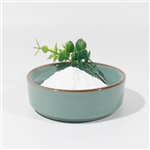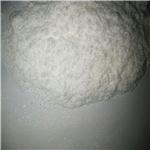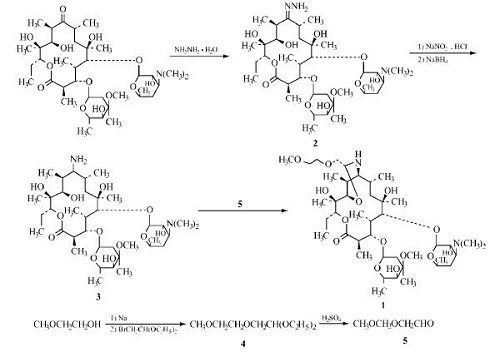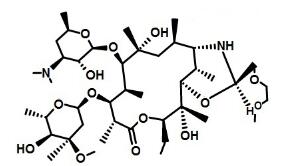- Dirithromycin
-

- $230.00 / 1kg
-
2023-06-26
- CAS:62013-04-1
- Min. Order: 10kg
- Purity: 99%
- Supply Ability: 500kg/month
- Dirithromycin
-

- $80.00 / 1kg
-
2023-02-13
- CAS:62013-04-1
- Min. Order: 1kg
- Purity: 99%
- Supply Ability: 100MT
- Dirithromycin
-

- $0.00 / 25Kg/Bag
-
2023-01-31
- CAS:62013-04-1
- Min. Order: 1Kg/Bag
- Purity: 99%
- Supply Ability: 20ton
|
| | Dirithromycin Chemical Properties |
| Melting point | 186-189° (dec) (Counter) | | Boiling point | 871.8±65.0 °C(Predicted) | | density | 1.19±0.1 g/cm3(Predicted) | | storage temp. | Sealed in dry,2-8°C | | solubility | Very slightly soluble in water, very soluble in methanol and in methylene chloride | | form | solid | | pka | 9.0 in 66% aq dimethyl fluoride | | color | white to off-white | | CAS DataBase Reference | 62013-04-1(CAS DataBase Reference) |
| Hazard Codes | Xn,Xi | | Risk Statements | 42/43-36/37/38 | | Safety Statements | 36-26 | | WGK Germany | 3 | | HS Code | 29419000 | | Toxicity | LD50 in mice (g/kg): >1 s.c.; >1 orally (Maier) |
| | Dirithromycin Usage And Synthesis |
| Background and overview | Dirithromycin is the second-generation erythromycin macrocyclic (fourteen member ring) lactone antibiotics; made from the condensation reaction between 2-methoxyethoxy acetaldehyde and erythromycylamine. It has similar structure to erythromycin. It can subject to in vivo non-enzymatic hydrolysis into erythromycin cyclic amines. It takes effect through targeting the 50S ribosomal subunit of sensitive pathogenic microorganisms, blocking the bacterial peptide bond formation, which further inhibits protein synthesis to play antibacterial activity.
Compared with erythromycin and other new macrocyclic lactone antibiotics, this drug has the following characteristics: (1) antibacterial effect: in addition to retaining the antibacterial effect against gram positive bacteria; it also has strong effect on a variety of G- bacteria, Anaerobic bacteria and other pathogens, such as Mycoplasma, Chlamydia and spirochete. Dirithromycin has stronger effect than erythromycin on Staphylococcus aureus and Staphylococcus epidermidis. (2) Pharmacokinetics: compared with other macrolide antibiotics in the vine, the half-life of erythromycin is longer with the plasma elimination tl/2 being longer than 24h. Its tissue permeability is strong. It can be administered once a day. So it will also be competitive in the market with characteristics that are different from other antibiotics.
Lilly's products in the United States was listed in Spain in September 1993, listed in 1996 in US after the approval of FDA and had been included in Pharmacopoeia USP 23; it was listed in 2005 in the domestic market. At present, there are a number of domestic dysthromycin enteric-coated tablets and enteric-coated capsules approved for clinical use.
| | Synthetic route | Route 1: erythromycin is first reacted with hydrazine hydrate to generate erythromycin hydrazone (2), erythromycin hydrazone is used for synthesizing erythromycylamine (3), and finally reacted with 2-methoxyethoxy acetaldehyde (5) to generate dysthromycin (1), as shown in the figure:
Route 2: Erythromycin is reacted with hydroxylamine to generate erythromycin oxime; erythromycin oxime can be reduced to obtain erythromycin amine, and is then condensed with 2- (2- methoxyethoxy) acetaldehyde ethylene glycol to generate dysthromycin (DRM), the specific reaction route is as follows:
| | Pharmacological effects | Dirithromycin has an antibacterial spectrum similar to erythromycin. It has strong inhibitory effect against chlamydia and mycoplasma. For the majority of gram-positive bacilli, the activity of Dirithromycin is lower than erythromycin by 2 to 4 times. For the treatment of Bordetella pertussis, it is 4 times more active than erythromycin. Its in vitro anti-staphylococcal activity is similar to or less than erythromycin. Dirithromycin, in less than or equal to 0.03 ~ 0.12μg / ml, can inhibit Streptococcus pyogenes and Streptococcus pneumoniae. Group B Streptococci are also inhibited at the same concentration. S. pneumoniae and L. reesei were inhibited at 0.12 μg / ml and 0.5 μg / ml, respectively. Streptozotocin-resistant streptozotocin, Streptomyces A and Streptococcus are also resistant to dirithromycin. The MIC90 of sensitive- or resistant-Staphylococcus was 0.5 μg / ml and 8 μ / ml, respectively. Dirithromycin does not inhibit aerobic gram-positive bacteria. In general, dirithromycin is 2 to 4 times more active than erythromycin. The activity of erythromycin against staphylococci and streptococci is not reduced by the addition of human serum. The activity of macrolide drugs in the pH value of 8.0 is 1 to 4 times larger than that in the pH value of 6.0. Dirithromycin has a slow bactericidal effect against Staphylococcus aureus and Haemophilus influenzae. Dirithromycin is resistant to enterococci and most methicillin-resistant Staphylococcus aureus and has close cross-resistance with other macrolides. 
Figure 1 Sructural Formula of Dysthromycin
| | Pharmacokinetics | Absorption: After oral administration of the product is rapidly absorbed, by non-enzymatic hydrolysis into biologically active substance erythromycylamine, its absolute bioavailability of about 10%. Healthy volunteers: (19-59 years old, single dose: 500 mg; multiple doses: 500 mg / day, 10 days).
Distribution: erythromycylamine can rapidly, widely distributed to the tissues with the intracellular concentration being higher than the tissue concentration, and the tissue concentration was significantly higher than the plasma concentration. The protein-binding rate was only 15-30% and the average apparent volume of distribution (VDSS) was 800L (540-1041L). Erythromycylamine has steady-state tissue concentration (500mg / time once a day)
Metabolism and excretion: the liver can almost not metabolize erythromycylamine. 81-97% of the drug can be eliminated by the bile pathway; and about 2% of the drug can be eliminated by the kidneys. Patients with normal renal function has the average plasma half-life of about 8 hours with the average elimination half-life of about 44 hours, the average apparent clearance of about 23L / h. The impact of food: The goods can be taken with food or food within 1 hour after taking. Studies have shown that taking an hour before meals, Cmax decrease by 33%, AUC decrease by 31%. The level of fat in food has almost no effect on bioavailability.
| | Clinical evaluation | 3299 patients, after oral administration of the drug (0.5 g / day) for 7-14 days, no toxicity-related death or disability have been found. Eighty-seven patients (2.6%) discontinued treatment due to adverse reactions, 35 (40%) discontinued due to nausea and abdominal pain. Another clinical trial (oral 0.5g / day for 5 days) showed that 35 patients (3.8%) discontinued treatment due to adverse reactions and 15 (43%) discontinued treatment for nausea and abdominal pain. Adverse reactions associated with the drug treatment were as follows: headache (7.7%), abdominal pain (7.1%), diarrhea (6.7%), nausea (5.9%), dyspepsia (2.6%), dizziness / dizziness Rash (1.4%), vomiting (1.1%) and so on. Increased platelet counts (3.8%), elevated potassium (2.6%), decreased bicarbonate (1.4%), increased CPK (1.2%), eosinophilia (1.2%), neutrophil increased %), Leukocytosis (0.8%) and so on.
| | Indications | It is applicable for patients over the age of 12 for the treatment of the following mild to moderate infections caused by sensitive bacteria:
- Acute exacerbation of chronic bronchitis: caused by Haemophilus influenzae, Moraxella catarrhalis, Streptococcus pneumoniae.
- Acute bronchitis: caused by Moraxella catarrhalis, Streptococcus pneumoniae.
- Community-acquired pneumonia: caused by Legionella pneumophila, Mycoplasma pneumoniae, Streptococcus pneumoniae.
- Pharyngitis and tonsillitis: caused by Streptococcus pyogenes.
- Simple skin and soft tissue infections: Staphylococcus aureus (methicillin sensitive strains), Streptococcus pyogenes caused.
| | Adverse reactions |
- Adverse reactions are mainly digestive system reactions such as abdominal pain, nausea, diarrhea, vomiting, dyspepsia, constipation, loose stools, dry mouth, mouth ulcers, changes in taste; other reactions include headache, dizziness, increased cough, rash, itching, etc.
- Laboratory tests showed platelet increase; ALT, AST bilirubin, creatinine rise and so on.
| | Medicine interactions | Terfenadine: This product does not affect terfenadine metabolism, in vitro tests show that the two drugs do not interact, but having interaction with erythromycin.
Theophylline: Under normal circumstances, patients taking theophylline, upon treatment of this product, do not have to adjust the theophylline dose or monitor blood concentration. In case when the patients need to maintain high blood concentration of theophylline, they should monitor the plasma concentration and adjust the dose to adapt.
Antacids or H2 receptor antagonists: taking antacids or H2 receptor antagonists immediately after taking this product can increase the absorption of erythromycin. The interaction between erythromycin and the following drugs has been clear, but the interaction with erythromycin is unclear, therefore, be cautious on the combination.
Triazolam: Triazolam can reduce the clearance rate and increase its pharmacological effects.
Digoxin: can increase the blood concentration of digoxin. Anticoagulants: Can increase the role of anticoagulants, especially in the elderly.
Ergotamine: produces symptoms of poisoning, such as peripheral vasospasm and insensitivity.
Other drugs: The interaction between erythromycin and the following drugs has been reported, such as: cyclosporin, cyclohexyl barbital, carbamazepine, alfentanil, dipyridamole, phenytoin, bromine, valproate, astemizole and lovastatin.
| | Precautions | Hepatic insufficiency: In patients with mild liver injury, the mean Cmax.AUC and volume of distribution increase slightly with increasing number of doses, but there is no need to adjust the dose.
Renal insufficiency: its mean Cmax. AUC tends to increase with a decrease in creatinine clearance, but patients in kidney damage (including dialysis) do not have to adjust their dose. It has been reported that virtually all broad-spectrum antibiotic drugs (including erythromycin) are used to produce pseudomembranous colitis. Therefore, if diarrhea occurs in patients taking antibiotics, it is important to consider this diagnosis. The extent of this colitis ranges from mild effect to life-threatening effect. For cases of mild pseudomembranous colitis, it is usually effective with merely withdrawal, but for moderate to severe cases, appropriate treatment should be taken.
| | Taboo |
- Banned in patients with erythromycin, erythromycin and other macrolide allergies.
- It should not be used in patients with suspicion or potential bacteremia because it does not provide effective drug concentration to the treatment site.
| | For Particular Population | Pregnant women: For reproductive studies of rats at a dose of up to 21 times the human dose (based on mg / m2) and a study using dose of 4 times the human dose for rabbits. The results show that this product has no damage to fertility and the fetus. Reproductive research on mice at doses up to 8 times the human dose: the results show that this product can significantly reduce fetal weight. However, there is no adequate, well-controlled clinical study of pregnant women. Therefore, pregnant women should weigh the pros and cons of using this product.
Childbirth: The impact on childbirth is unclear. Breastfeeding: it is not clear whether breastfeeding women contains this product inside the milk; but in breast milk, it has been found in other macrolide antibiotics, and rodents also contain this product in breast milk. Therefore lactating women should be used with caution.
For children under the age of 12: The safety and effectiveness for using of this product has not yet been determined.
Elderly patients: Cmax.AUC tends to increase with age, but no statistically significant difference or clinical. Therefore, the elderly patients do not have to adjust the dose when used.
| | Description | Dirithromycin, an orally active oxazine derivative of erythromycin, is a secondgeneration
macrolide antibiotic. It was first introduced in Spain for the treatment of respiratory
tract, skin and soft tissue infections. It is safe and effective in treating acute bronchitis,
acute bacterial exacerbation of chronic bronchitis, pneumonia, pharyngitis, and tonsillitis.
Dirithromycin has been reported to have a similar antimicrobial spectrum and potency to
erythromycin. However, compared to other macrolide antibiotics, dirithromycin has improved
oral bioavailability, higher tissue permeability and longer duration of action. The once-daily
therapy regiment is advantageous in terms of patient compliance and is a good alternative for
patients who are unable to take penicillin. | | Description | Dirithromycin is a macrolide antibiotic. It is a prodrug of erythromycylamine that has outstanding activity against Campylobacter. Dirithromycin is a group 3 agent with respect to its interaction with the cytochrome P450 (CYP) isoform 3A4, as it interferes poorly with CYP3A4 in vitro and generally does not alter drug metabolism in vivo. | | Chemical Properties | white crystals | | Originator | Boehringer
Ingelheim (Germany) | | Uses | antihypertensive | | Uses | Semi-synthetic derivative of Erythromycin. Antibacterial | | Uses | Dirithromycin is a macrolide antibiotic pro-drug of 9S-erythromycylamine, a close analogue of erythromycin in which the 9-keto group is replaced with an amino group in the S-configuration. Although erythromycylamine overcomes the acid instability of erythromycin, it is poorly absorbed following oral administration. Dirithromycin is formed by reacting erythromycylamine with an aldehyde to form a Schiff base which undergoes cyclisation to an oxazine with the C11-alcohol. Dirithromycin provides higher tissue levels and prolonged in vivo half-life by slowly releasing erythromycylamine. | | Definition | ChEBI: The hemi-aminal resulting from the condensation of the erythromycin derivative (9S)-erythromycyclamine with 2-(2-methoxyethoxy)acetaldehyde. As the oxazine ring containing the hemi-aminal group is unstable under both acidic and alkaline co
ditions, dirithromycin functions as a more lipid-soluble prodrug for (9S)-erythromycyclamine. Administered as enteric coated tablets to protect it from acid catalysed hydrolysis in the stomach, it is used to treat respiratory tract, skin,
nd soft tissue infections caused by susceptible organisms. | | Manufacturing Process | The reactions were conducted for the synthesis of dirithromycin according to
the following procedure. 2-(2-Methoxyethoxy)acetaldehyde dimethyl acetal
(12 g, 2.7 eq) was placed in a three-neck flask equipped with a mechanical
stirrer and dissolved in 60 ml of acetonitrile containing 4% water. p�Toluenesulfonic acid (200 mg, 0.04 eq) was added and the mixture was stirred
under a nitrogen atmosphere for 3 hours at 30°C, after which, the
temperature was adjusted to 23°C.
Erythromycylamine (20 g, 1 eq) was added over a 20 minute period and
stirring continued for 12-16 hours at 23°C. The reaction mixture was cooled
to 0°C for 2 hours and then filtered to recover dirithromycin crystals. The
crystals were washed with cold acetonitrile and dryed in vacuo at 40°C. Theyield of final product was 84.5% with a potency of 95.4% (average of three
reactions). Crystalline dirithromycin a condensation product of 2-(2-
methoxyethoxy)acetaldehyde dimethyl acetal and erythromycylamine. | | Brand name | Dynabac (Lilly);Nortron. | | Therapeutic Function | Antibacterial | | General Description | The incidence and severity of GI adverse effects associatedwith dirithromycin are similar to those seen with oralerythromycin. Preliminary studies indicate that dirithromycinand erythromycyclamine do not interact significantly with cytochromeP450 oxygenases. Thus, the likelihood of interferencein the oxidative metabolism of drugs such as phenytoin,theophylline, and cyclosporine by these enzymes may be lesswith dirithromycin than with erythromycin. Dirithromycin isrecommended as an alternative to erythromycin for the treatmentof bacterial infections of the upper and lower respiratorytracts, such as pharyngitis, tonsillitis, bronchitis, and pneumonia,and for bacterial infections of other soft tissues and theskin. The once-daily dosing schedule for dirithromycin is advantageousin terms of better patient compliance. Its place intherapy remains to be fully assessed. | | Pharmaceutical Applications | A prodrug of erythromycylamine, a semisynthetic erythromycin A derivative, formulated for oral administration. Activity against respiratory pathogens is generally poorer than that of erythromycin A.
The long apparent elimination half-life (30–44 h) allows once-daily administration. Around 60–90% of a dose is converted to erythromycylamine within 35 min after intravenous administration. After oral administration of single doses of 500–1000 mg to healthy volunteers, the peak plasma concentrations ranged from 0.29 to 0.64 mg/L after 4–5 h. The absolute bioavailability after oral administration is about 10%. It achieves a higher concentration than erythromycin in some tissues. After a 500 mg single oral dose, the mean peak biliary concentration was 139 mg/L. Renal and non-renal clearance was lower in patients with biliary disease than in other patients or healthy volunteers.
About 60–80% of an oral dose and over 80% of an intravenous dose are eliminated in the feces, predominantly as erythromycylamine. Dosage adjustments do not appear necessary in patients with mild or moderate hepatic, biliary or renal impairment. Negligible amounts of the drug are removed during hemodialysis.
Adverse events are similar to those found with other macrolides. Gastrointestinal events are most common; around 5% of patients experience abdominal pain, diarrhea or nausea.
It has been used in community-acquired infections of the respiratory tract and skin and soft-tissue infections. It is no longer widely available. |
| | Dirithromycin Preparation Products And Raw materials |
|